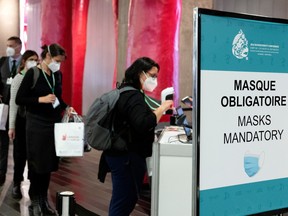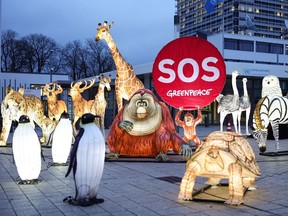Who will attend, what will they try to achieve, what are the sticking points? These and other questions answered here.

Beluga whales, woodland caribou and the red-headed woodpecker are among the animals on Quebec’s endangered species list.
Around the world, an estimated 1 million animal and plant species face extinction.
Sign up to receive daily headline news from the Montreal Gazette, a division of Postmedia Network Inc.
Thanks for signing up!
A welcome email is on its way. If you don't see it, please check your junk folder.
The next issue of Montreal Gazette Headline News will soon be in your inbox.
That’s more than ever before in human history, experts say. And the decline is accelerating.
Over two weeks this month, 20,000 people from around the world will gather in Montreal to try to preserve the planet’s biodiversity.
Here’s what you should know about the gathering, known as COP15.
What is biodiversity and why is it in trouble?
In a word, biodiversity refers to nature — from insects, plants and animals to the forests, streams and oceans they live in.
Nature is vital, helping sustain humanity by supporting food production, purifying air and water, and providing the raw materials for new medicines.
It’s under threat due to deforestation, overfishing, invasive species, industrial farming, pollution and climate change.
What is COP15?
It’s a meeting — Dec. 7-19 — of governments from around the world.
The name — COP15 — refers to the fact it’s the 15th conference of the parties of the United Nations Convention of Biological Diversity (CBD), adopted in 1993.
The 196 countries that adhere to the CBD meet every two years.
This year’s summit is key. It’s where the planet will negotiate targets to meet by 2030.
With 20,000 delegates, it’s the biggest-ever UN environmental conference.
The Montreal summit is the second part of a meeting that began virtually in 2021 and was to have concluded in Kunming, China. Severe Chinese COVID-19 lockdowns led organizers to move the last part of the conference to Montreal.
The CBD has three main objectives: 1. Conserving biological diversity. 2. Ensuring the sustainable use of the components of biological diversity. 3. Ensuring the fair and equitable sharing of the benefits arising from the use of genetic resources — the genetic material of plants, animals or micro-organisms.
What will negotiators try to achieve?
It’s a tall order.
The aim: a detailed global agreement on slowing biodiversity loss and restoring the delicate balance between humans and nature.
Detailed targets could focus on reducing the scourge of invasive alien species, cutting pesticide use and plastic waste, and reducing government incentives harmful to biodiversity, redirecting that money to nature-positive activities.

What role will Indigenous issues play?
Canada says it wants a deal that recognizes the role and contributions of Indigenous Peoples to the preservation of biodiversity.
A group of Indigenous leaders from around the world last week said COP15 must “shift the colonial paradigm that centers around extraction and decolonize our approach to nature protection by upholding the rights of Indigenous Peoples.”
Some critics say the 30-by-30 target could be problematic, noting that historically, protected areas have often been carved out of Indigenous Peoples’ ancestral lands, resulting in land dispossession, cultural loss and human rights violations.
Will world leaders be there?
Prime Minister Justin Trudeau will open COP15 on Dec. 6 with António Guterres, secretary-general of the United Nations, and Huang Runqui, China’s minister of ecology and environment.
However, it’s unclear if any other world leaders will attend.
Technically, China is the host of COP15 and would be responsible for inviting heads of state.
Canada-China relations have been frosty for years, culminating in an awkward exchange between Chinese President Xi Jinping and Trudeau at a G20 summit in Indonesia last month.
Who negotiates?
In Canada’s case, the negotiating team is led by Environment Minister Steven Guilbeault and includes Catherine Stewart, the country’s ambassador for climate change.
Canada’s delegation includes MPs, senators, Indigenous leaders, scientists, academics, environmentalists, businesspeople, non-governmental organizations and representatives from every province and territory.
Negotiating teams will thrash out details of the agreement in a series of sessions, with government ministers arriving for a “high-level segment” from Dec. 15 to 17.
Are they close to a deal?
No. After several preparatory negotiating sessions ahead of COP15, countries have only agreed to a tiny section of a draft agreement.
By one estimate, there are about 1,800 “square brackets” in the draft.
When UN agreements are being hammered out, square brackets indicate sections that have been proposed but have not been agreed on. In this case, some of the 1,800 brackets include opposite views on key elements.
What are the sticking points?
More than 100 countries have already agreed to include a so-called 30-by-30 target in the final agreement, under which 30 per cent of the world’s land and water will be protected by 2030.
However, many other possible goals are fraught with challenges, and all parties need to agree to a final agreement since the CBD works by consensus.
Take money.
With huge amounts needed (up to $700 billion annually), it’s unclear whether enough will be pledged to protect and restore biodiversity. Rich countries are being urged to pitch in more to help poor countries, which are feeling the brunt of the decline of biodiversity.
Other sticking points could revolve around the fair and equitable sharing of benefits of genetic resources — in the creation of pharmaceuticals, for example. Companies and consumers in developed countries typically benefit more from resources. Developing countries say more benefits should flow back to countries where genetic resources came from.
What’s the mood on the world stage?
Wars, political tension and economic uncertainty make for an environment that’s not conducive to multilateral agreements.
However, some see glimmers of hope.
The United States, a powerful force but the only country in the world that isn’t a party to the CBD, will be at COP15.
President Joe Biden recently appointed a special envoy for biodiversity and water resources. And the White House has already agreed to conserve at least 30 per cent of lands and waters by 2030.
The election of Luiz Inácio Lula da Silva in Brazil is also seen as good news for nature. Known as Lula, he has vowed to protect the Amazon rainforest, one of the planet’s most biodiverse habitats. He will unseat President Jair Bolsonaro, under whom Amazon deforestation surged.
Though the incoming president takes over on Jan. 1, part of Lula’s transition team is expected in Montreal for COP15.
When was the last biodiversity plan signed?
In Aichi, Japan, in 2010, countries agreed to a 10-year plan. None of the targets they set have been met.
Critics say the goals laid out in Japan were too complicated and the plan to achieve them wasn’t clear. As a result, it was difficult to measure success. Financial resources were also lacking.
This time, many countries are pressing for targets that are more measurable, with governments required to report on progress.
ariga@postmedia.com
-

Saving nature is the goal at COP15 in Montreal. Will Quebec step up?
-

COP15 in Montreal: Brace for protests, civil disobedience and student strikes
-

COP15: Innu 'exasperated' by Quebec’s failure to protect caribou on North Shore
-

COP15: Montreal is ready for flood of tens of thousands of people: officials
-

Allison Hanes: How much can be accomplished at COP15, and how can we help?


